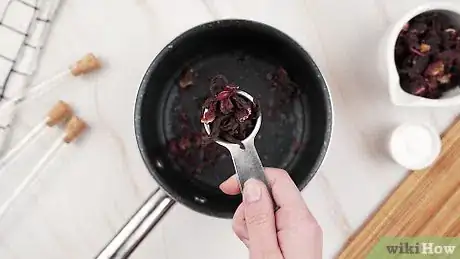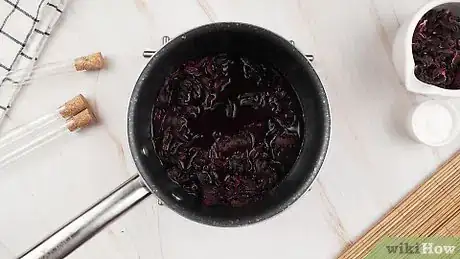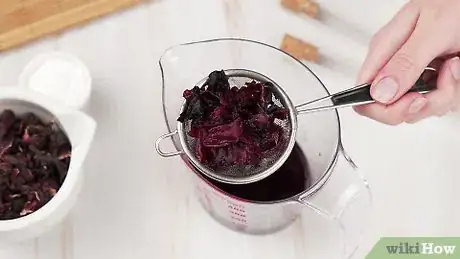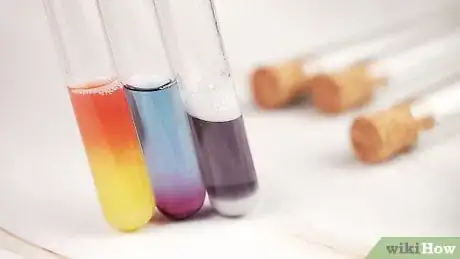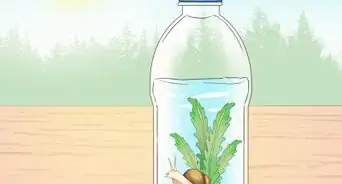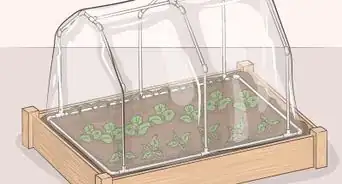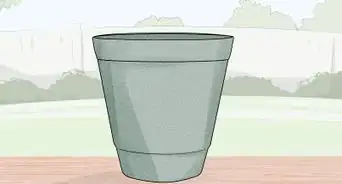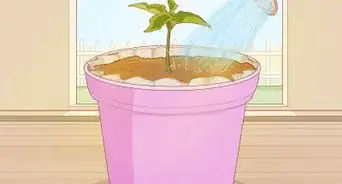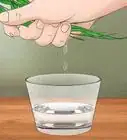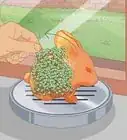This article was co-authored by wikiHow staff writer, Hannah Madden. Hannah Madden is a writer, editor, and artist currently living in Portland, Oregon. In 2018, she graduated from Portland State University with a B.S. in Environmental Studies. Hannah enjoys writing articles about conservation, sustainability, and eco-friendly products. When she isn’t writing, you can find Hannah working on hand embroidery projects and listening to music.
The wikiHow Video Team also followed the article's instructions and verified that they work.
This article has been viewed 113,937 times.
Learn more...
If you’re looking for a fun science experiment to do at home, making an indicator solution might be the perfect project. By mixing dried hibiscus leaves and water, you can make a cheap and sensitive chemical indicator for bases and acids in just a few minutes. After that, you can go wild with testing household items to see where they fall on the pH scale.
Steps
Expert Q&A
-
QuestionWhat is the difference between acids and bases?
 Chris Hasegawa, PhDDr. Chris Hasegawa was a Science Professor and the Dean at California State University Monterey Bay. Dr. Hasegawa specializes in teaching complex scientific concepts to students. He holds a BS in Biochemistry, a Master’s in Education, and his teaching credential from The University of California, Davis. He earned his PhD in Curriculum and Instruction from The University of Oregon. Before becoming a professor, Dr. Hasegawa conducted biochemical research in Neuropharmacology at the National Institute of Health. He also taught physical and life sciences and served as a teacher and administrator at public schools in California, Oregon, and Arizona.
Chris Hasegawa, PhDDr. Chris Hasegawa was a Science Professor and the Dean at California State University Monterey Bay. Dr. Hasegawa specializes in teaching complex scientific concepts to students. He holds a BS in Biochemistry, a Master’s in Education, and his teaching credential from The University of California, Davis. He earned his PhD in Curriculum and Instruction from The University of Oregon. Before becoming a professor, Dr. Hasegawa conducted biochemical research in Neuropharmacology at the National Institute of Health. He also taught physical and life sciences and served as a teacher and administrator at public schools in California, Oregon, and Arizona.
Retired Science Professor & Dean The basic difference between acids and bases is the difference in the amount of ions in those solutions and how those are put out.
The basic difference between acids and bases is the difference in the amount of ions in those solutions and how those are put out. -
QuestionWhy does hibiscus flower indicator change color when added to an acid/base?
 wikiHow Staff EditorThis answer was written by one of our trained team of researchers who validated it for accuracy and comprehensiveness.
wikiHow Staff EditorThis answer was written by one of our trained team of researchers who validated it for accuracy and comprehensiveness.
Staff Answer wikiHow Staff EditorStaff AnswerHibiscus flowers have anthocyanin in them, which is what gives them their color. This pigment automatically reacts with chemicals and changes different colors depending on their acidity or basicness.
wikiHow Staff EditorStaff AnswerHibiscus flowers have anthocyanin in them, which is what gives them their color. This pigment automatically reacts with chemicals and changes different colors depending on their acidity or basicness. -
QuestionDoes the hibiscus indicator work only if it is freshly prepared? Can I preserve it?
 wikiHow Staff EditorThis answer was written by one of our trained team of researchers who validated it for accuracy and comprehensiveness.
wikiHow Staff EditorThis answer was written by one of our trained team of researchers who validated it for accuracy and comprehensiveness.
Staff Answer wikiHow Staff EditorStaff AnswerChemical indicators work best if you use them right away. Preparing your hibiscus indicator a day ahead of time is probably fine, but if you wait much longer than that it won't work as well.
wikiHow Staff EditorStaff AnswerChemical indicators work best if you use them right away. Preparing your hibiscus indicator a day ahead of time is probably fine, but if you wait much longer than that it won't work as well.
Things You’ll Need
- 2 to 3 grams of dried hibiscus petals
- 150 mL beaker
- Bunsen burner or a hot plate
- 100 mL beaker
- 1 tsp (5.6 g) of a chemical of your choice
- Test tube
- Dropper
References
- ↑ https://www.flinnsci.com/api/library/Download/75bfca43b9da4346a173bf3ac21fd68a
- ↑ https://www.youtube.com/watch?v=-V5LJ9O9LBU&t=49s
- ↑ https://www.flinnsci.com/api/library/Download/75bfca43b9da4346a173bf3ac21fd68a
- ↑ https://www.scholarsresearchlibrary.com/articles/extraction-of-the-cyanidin3sophoroside-from-hibiscus-rosasinensis-an-efficient-natural-indicator-over-a-wide-range-of-acidbase-tit-12313.html
- ↑ https://www.youtube.com/watch?t=95&v=-V5LJ9O9LBU&feature=youtu.be
- ↑ https://www.youtube.com/watch?v=6KMP2Foj93U&t=144s
- ↑ https://www.flinnsci.com/api/library/Download/75bfca43b9da4346a173bf3ac21fd68a
About This Article
To make a fun pH indicator at home with hibiscus petals, place the petals in a heat-proof beaker or pan with water. Heat the water over a Bunsen burner or hot plate and let it boil for about 5 minutes, or until the water turns dark red. Let the mixture cool for 5 to 10 minutes, then gently pour it through a strainer to remove the petals. Pour the chemicals you’d like to test into individual test tubes, then add a few drops of the hibiscus dye into each tube. Watch the liquid change color depending on how acidic or basic it is. Read on to learn how to interpret the results of your pH indicator test!
